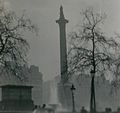Smog emergency situations
Our knowledge of the effects of pollution on humans is still incomplete. Determining these effects is complicated mainly due to the difficulty of modeling these stress situations. Thus, we can obtain valuable information about the effect of pollutants in the air on human health by studying documented emergency situations in the history of mankind.
The Great Smog in London (1952)[edit | edit source]
This dramatic event from December 1952 is a classic example of the fact that under normal conditions, a stabilized situation can turn into a crash under meteorological changes. A thermal inversion associated with fog affecting England (especially London and the Thames Valley) resulted in the usual smoke concentration increasing by 5x. The level of sulphur oxide, which is typical of London's reducing smog, reached 6 times its usual level during this period. The concentration of emissions began to rise sharply about 12 hours after the arrival of the dense fog. These changes led to an unusual incidence of disease and death. In particular, respiratory diseases dominated - cough with a small amount of sputum, nasal discharge, sore throat and also sudden vomiting. The incidence of these diseases has increased almost fourfold. Individuals who already had similar diseases in their anamnesis and also patients who were treated for heart problems were more seriously affected. Dyspnoea, cyanosis, mild temperature and bronchospasm occurred in severely ill patients. Most of these diseases had a sudden onset. Statistical data showed that men were affected more often than women and most of the patients were over 45 years old. About 4,000 more deaths were recorded in the two-week period (the week of the Great Smog and the week after) than in the same period in previous years. A later study of the situation concluded that the devastating effects were caused by a combination of fog, cold temperature, sulphur dioxide and ash from coal smoke . The results of the surveys were used and based on them, a number of recommendations were made for the effective prevention of another similar situation.
Los Angeles - irritating photochemical smog[edit | edit source]
A similar example to the previous one is the occasional occurrence of irritating smog during clear summer days in the Los Angels area. This location is bordered on one side by the Pacific Ocean coast and on the north side is closed by mountain ranges. Therefore, a characteristically slowed air flow occurs here, which records the occurrence of smog. This oxidizing smog from the exhaust gases goes through a series of photochemical reactions under low air humidity and intense sunlight. Their result is the so-called photochemical smog, the components of which are constantly transforming each other due to ongoing reactions. Its basic components are air oxygen, UV radiation, nitrogen oxides, hydrocarbons (mainly unsaturated) and sulfur dioxide. The products of photochemical reactions are ozone, peroxyacetyl nitrate, aldehydes and sulfuric acid. During the period of smog, the number of hospitalizations of patients with respiratory and heart problems increases, and city dwellers often complain of eye, nose and throat irritation. Children at school were also found to be more restless than usual during smog. Like the situation in London in 1952, this occurrence of smog is an example of how an abnormal accumulation of normal emissions can be caused by a change in meteorological conditions.
1984 Bhopal Crash[edit | edit source]
The disaster that occurred in central India was caused by an accident at a chemical plant belonging to the Union Carbide concern. During production, 900 liters of water leaked into a tank containing methyl isocyanate stabilized with phosgene. The hydrolysis of phosgene produced HCl, which catalyzes the polymerization of methyl isocyanate. During this reaction, a significant amount of heat was released, which caused an increase in pressure in the tank and a subsequent 'leakage of methyl isocyanate (and probably hydrogen cyanide) into the atmosphere. Late reporting of the accident and insufficient emergency measures led to a crash with tragic consequences. The leaked chemicals hit the slums near the factory. In addition, after hearing the sirens, part of the population got the impression that it was a fire and approached the factory in an attempt to help put it out. About 150,000 people were affected, 1,800 victims died and others suffered permanent consequences, especially eye damage. Many of the health problems could have been prevented by a simple measure – lying on the ground and covering your face with a wet piece of cloth. Similar accidents show the necessity of informing the population about how to behave in crisis situations and the necessary preparation of emergency plans for managing them.
Links[edit | edit source]
Related Articles[edit | edit source]
External links[edit | edit source]
Source[edit | edit source]
- BENCKO, Vladimír. Hygiena : Učební texty k seminářům a praktickým cvičením. 2. edition. Karolinum, 1998. 185 pp. ISBN 80-7184-551-5.
- BENCKO, Vladimír – KLEIN, Otakar. Ekologie člověka. 1. edition. Karolinum, 1997. 150 pp. ISBN 80-7184-432-2.
- SYMON, Karel – BENCKO, Vladimír. Znečištění ovzduší a zdraví. 1. edition. Avicenum, 1988. 252 pp.






